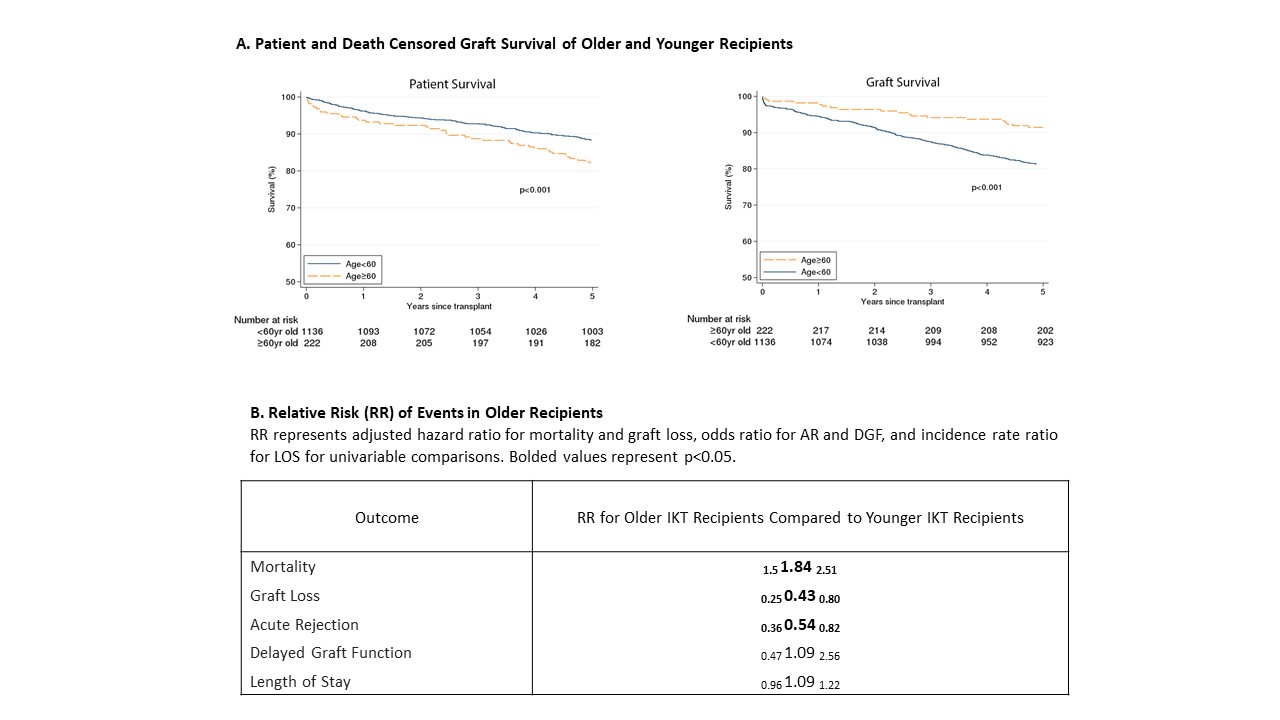Outcomes after Incompatible Living Donor Kidney Transplantation in Older Recipients
1Johns Hopkins School of Medicine, Baltimore, MD, 2Surgery, University of Alabama at Birmingham, Birmingham, AL
Meeting: 2019 American Transplant Congress
Abstract number: B276
Keywords: Elderly patients, Highly-sensitized, Kidney transplantation, Outcome
Session Information
Session Name: Poster Session B: Kidney Living Donor: Quality and Selection
Session Type: Poster Session
Date: Sunday, June 2, 2019
Session Time: 6:00pm-7:00pm
 Presentation Time: 6:00pm-7:00pm
Presentation Time: 6:00pm-7:00pm
Location: Hall C & D
*Purpose: Older individuals are the fastest-growing sub-group of transplant candidates who may face increased risks when considering incompatible living donor kidney transplantation (IKT) due to more comorbidities and depressed immune function. To inform appropriate risk counseling, we sought to quantify IKT outcomes in older recipients.
*Methods: Using a 25-center SRTR-linked IKT cohort, we compared outcomes of 222 older (age≥60) to 1136 younger (age<60) recipients. We analyzed mortality and death-censored graft survival (DCGS) using Cox regression, acute rejection (AR) in the first 12 months and delayed graft function (DGF) using logistic regression, and length of stay (LOS) using negative binomial regression, adjusting for recipient characteristics and antibody strength.
*Results: Compared to younger recipients, older recipients were more likely to bee Luminex+ (30.6% vs 22.9%) and less likely to be Flow+ or CDC+ (47.3% vs 51.2% and 22.1% vs 25.9%, p=0.04). However, both mortality and death censored graft failure (DCGF) did not vary by level of antibody strength (mortality: p for interaction >0.05; DCGF: p for interaction >0.05). Post-IKT, 1 and 5-year patient survival was lower (93.7% vs. 96.2% and 58.11% vs 73.6%, p<0.001) and 1 and 5-year DCGS was higher (97.8% vs 94.5% and 85.6% vs 68.8%, p<0.001) in older recipients (Figure, A). After adjustment, older recipients had a 1.84x increased risk of mortality (adjusted Hazard Ratio [aHR]:1.351.842.51, p<0.001), were 2.33x less likely to develop DCGF (aHR:0.250.430.80, p=0.007), and were 1.85x less likely to develop AR (adjusted Odds Ratio [aOR]: 0.360.540.82, p=0.004), with no differences in DGF (aOR:0.471.092.56, p=0.8) or LOS (adjusted Incidence Rate Ratio [aIRR]:0.961.091.22, p=0.2).
*Conclusions: Post-IKT, older recipients have worse survival, lower rates of DCGF and AR, and similar DGF and LOS compared to younger recipients. Despite these differences, the effect of HLA strength was not different among older recipients compared to younger recipients. These findings should be considered when counseling older recipients about IKT.
To cite this abstract in AMA style:
Long J, Jackson K, Motter J, Bae S, Massie A, Waldram M, Covarrubias K, Chen J, Orandi B, Desai N, Segev D, Garonzik-Wang J. Outcomes after Incompatible Living Donor Kidney Transplantation in Older Recipients [abstract]. Am J Transplant. 2019; 19 (suppl 3). https://atcmeetingabstracts.com/abstract/outcomes-after-incompatible-living-donor-kidney-transplantation-in-older-recipients/. Accessed December 25, 2025.« Back to 2019 American Transplant Congress

